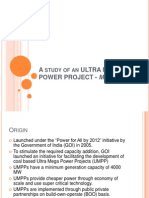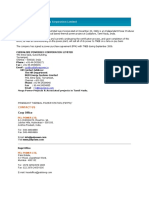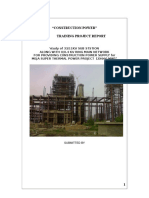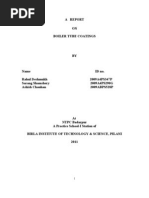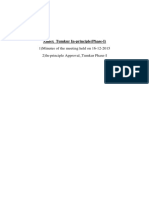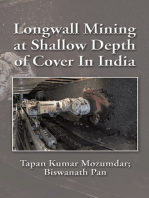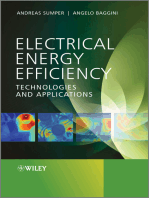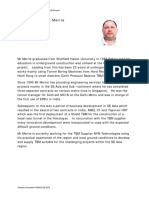03-4000mw Mundra Ultra Mega Power Project Brief Overview-Brrangaswamy
03-4000mw Mundra Ultra Mega Power Project Brief Overview-Brrangaswamy
Uploaded by
Prashant PatilCopyright:
Available Formats
03-4000mw Mundra Ultra Mega Power Project Brief Overview-Brrangaswamy
03-4000mw Mundra Ultra Mega Power Project Brief Overview-Brrangaswamy
Uploaded by
Prashant PatilOriginal Description:
Original Title
Copyright
Available Formats
Share this document
Did you find this document useful?
Is this content inappropriate?
Copyright:
Available Formats
03-4000mw Mundra Ultra Mega Power Project Brief Overview-Brrangaswamy
03-4000mw Mundra Ultra Mega Power Project Brief Overview-Brrangaswamy
Uploaded by
Prashant PatilCopyright:
Available Formats
03-4000MW MUNDRA ULTRA MEGA POWER PROJECT BRIEF OVERVIEW
Brief profile of B.R.Rangaswamy,
General Manager civil,
Tata Consulting Engineers Ltd
Mr B.R.Rangaswamy is a Civil Engineer with an overall experience of over
32years.
He has completed his Bachelor of Engineering from BMS College of engineering
and Post graduation in pre stressed concrete structures from UVCE of Bangalore
university
After a 3 year stint as Assistant Engineer at HAL,Bangalores Design Dept, Mr.
Rangaswamy joined TCE in 1981. He has engineered a wide range of projects of
Thermal Power plants, Hydro power Plants, Mini Hydro power plants, DG power
plants, and Combined cycle power Plants.
Some of the projects he was involved are Raichur Thermal Power Station,Karnataka
Units# 1,2,3,4,and 7,Wanakbori Power plant ,Gujarat Units #4,5&6,Jojobera power
plant ,Jharkhand Units # 2,3,4&5,Hindustan polymers DG plant, He was also
associated with 1X250 MW Trombay Power Station , 1X 120MW Power House 6 at
TISCO, Jamshedpur and Sanjay Gandhi thermal power plant 1x500MW at
Birshinghpur,MP
Some of the Hydro plants are 3x24MW ,530M high head Bhivpuri Hydro power plant
,Bhivpuri 2x1.35 MW tail race hydro plant, 2x9MW Chunchanakatte hydro
plant,Mandagere Hydro plant .
Some of the foreign assignments are ,he was deputed to Iran in 1992 for about 15
months for Gharb Thermal Power Plant. He was also deputed to Italy in 2002 for
about 3 months for the Enel Power company for project at Qatar. He is also
designated as civil specialist engineer to associate with KEMA of Holland for
2x120MW Peaking Power plant at Siddirgunj in Bangladesh.He is associated with
captive power plant at TATA CORUS power plant at Holland
Currently, he is working as Project Lead Engineer
Ultra Mega Power Plant at Mundra ,Gujarat .
He is also the Civil Discipline head for Bangalore office
Seminar Document- REDECON 2010
for the prestigious 4000MW
03-4000MW MUNDRA ULTRA MEGA POWER PROJECT BRIEF OVERVIEW
4000MW MUNDRA ULTRA MEGA POWER
PROJECT BRIEF OVERVIEW
B R Rangaswamy
General Manager Civil
Tata Consulting Engineers Ltd
73/1 St Marks Road
Bangalore 560001
ABSTRACT: Through tariff based international competitive bidding, Government of
India has launched Ultra Mega Power Projects (UMPP). Mundra UMPP in Gujarat is
the first such project which is scheduled for commissioning in early 2011. Coastal
Gujarat Power Limited, a TATA Power Company has won the contract to construct
the first UMPP and Tata Consulting Engineers are involved in engineering the plant.
This paper discusses the many firsts in the country that this plant takes pride in,
scale of the project and salient features. The paper also discusses civil engineering
highlights related to certain critical systems and studies conducted in engineering the
plant and its systems. The systems / studies discussed include geological features,
plot plan, turbine building, and turbine foundation, cooling water system, concrete
volute pumps and reinforced concrete chimneys. The intent of the discussion is to
highlight challenges faced and enormity of scale to the civil engineering community
participating in this conference.
INTRODUCTION[1,2,3,4]
Power sector reforms were initiated in 1991 to encourage competition
and seek private participation in each sub-element of the sector,
namely generation, transmission and distribution. Fast Track private
sector projects with Government guarantees followed by the Mega
Power Policy were announced to attract large-scale private investment
into the sector. A major, new initiative for promoting competition and
attracting private investment in the power sector launched in the last
year of the Tenth Plan was the Ultra Mega Power Projects (UMPP)
program.
The Electricity Act 2003 requires competitive tariff-based
bidding from independent power producers. To initiate the process and
to realize the benefits of international competitive bidding and
economies of scale, UMPP program was launched for development of
Seminar Document- REDECON 2010
03-4000MW MUNDRA ULTRA MEGA POWER PROJECT BRIEF OVERVIEW
coal-based plants with a capacity of 4000 MW or above through tariffbased competitive bidding. The projects will include development of
power projects as well as associated coal mines in respect of pithead
sites and imported coal sourcing in respect of coastal sites. These
projects will be awarded to developers on BOO basis.
Nine Ultra Mega Power Projects (UMPPs) of 4000 MW each have been
originally identified for development under international competitive
bidding route. These include 4 pit head and 5 coastal sites.
Four
UMPPs namely Sasan in MP, Krishnapatnam in Andhra Pradesh, Tilaiya
in Jharkhand have been awarded to M/s Reliance Power Ltd. and
Mundra in Gujarat have been awarded to M/s Tata Power Ltd. Sites in
respect of UMPPs in Chhattisgarh and Tamil Nadu have been finalized.
Efforts are being made to bring them to bidding stage.
Andhra
Pradesh has confirmed second UMPP in Prakasham District. Efforts are
being made for selection of sites for two additional UMPPs in Orissa
and the second UMPP in Gujarat.
The purpose of this paper is to
describe salient features and civil engineering highlights of TATA power
owned Mundra UMPP briefly.
MUNDRA UMPP SALIENT FEATURES
Mundra is located on the coast of Gujarat in the Gulf of Kutch. The
project site is located 35km to the south of Bhuj town, on the northern
shore of the Gulf of Kutch of the Arabian Sea and about 25 kilometres
west of Mundra Port. The site of the proposed plant is an area of 2500
acres and is located approximately 22km to the north of Mundra town.
Coastal Gujarat Power Limited (A TATA Power Company) is building
the 4000 MW plant. Theoretical generation capacity of the plant is 5 x
Seminar Document- REDECON 2010
03-4000MW MUNDRA ULTRA MEGA POWER PROJECT BRIEF OVERVIEW
830 MW. The zero date (start date) for the project was September 01,
2007.
First unit is planned to get commissioned on 28th February
2011. The other four units are planned for commissioning at 4 months
interval successively thereafter.
As this is the first UMPP in the country, a total of 55 basic studies have
been performed on engineering of various systems and subsystems in
the
major
engineering
disciplines
involved
mechanical,
civil,
electrical and instrumentation and control. A total of 96 procurement
packages have been released and one of the key challenges is
coordination among different vendors. A total of 1250 engineering
drawings are expected to be released for construction and the number
of vendor drawings exceeds 14000.
The amount of cement used is expected to be around 232,000 tones.
A total of 47,000 tons of reinforcement steel is expected to be used for
a total concrete quantity of around 560,000 m3.
The quantity of
structural steel used will be approximately 66,000 tons. 7500 tons of
piping will be in the plant when it gets commissioned.
Entire coal for this project is being imported.
Coal is transported to
site through a conveyor system from the New Adani Port directly to
the plant.
Requirement of coal is about 42,840 tons per day
amounting to 13 million tons every year. Fly ash generated is about
50 tons per hour (1,861,500 tons per year) and the bottom ash is
approximately 10 tons per hour or 372,300 tons per year.
Sea is the source for water requirement.
Sea water is used for the
purpose of cooling water requirements and desalinated sea water is
Seminar Document- REDECON 2010
03-4000MW MUNDRA ULTRA MEGA POWER PROJECT BRIEF OVERVIEW
used for raw water requirements. Total water requirement for the five
units is about 730,000 m3 per hour.
The total length of cables laid in the plant area amounts to 1000km.
The distributed control system (DCS) is designed for an input / output
signal count of 50000. Power evacuation is through 400kV lines.
Some of the first times in the country for this plant are:
Mundra when commissioned will be the first 800MW Supercritical
plant
P92 material is being used for the main steam and hot reheat
piping
2 x 50% Motor driven Boiler Feed Pumps (BFP)
BFP discharge system for maximum operating pressure
60,000 m3/hr concrete volute cooling water pumps
Thin wall titanium tube twin condenser with equalizing duct
310 mVA Single phase generator transformer
800 MW class Hi-Fidelity Supercritical simulator
Elimination of hard wired cabling to DCS for control and
monitoring
3 Flue Chimney with base shell diameter of 32m
7km long dredged cooling water intake channel
Open CW Sump structure with gantry crane
KEY CIVIL ENGINEERING HIGHLIGHTS
For a plant of this magnitude and scale, it is almost impossible to
discuss all aspects of engineering in a single discussion of limited time
Seminar Document- REDECON 2010
03-4000MW MUNDRA ULTRA MEGA POWER PROJECT BRIEF OVERVIEW
/ length. It must also be appreciated that in a plant of this scale, each
and every structure that is designed / constructed will have to be
bigger as compared to power plants of lesser capacity that have been
in use and there will be some complexity of scale involved in the
design. However, keeping in mind the length of the manuscript and
the time available, some of the key civil engineering highlights are
only discussed briefly in this section.
GEOLOGY, GEOTECHNICAL EXPLORATION AND EVALUATION[5]
Geological
aspects
and
geotechnical
exploration
studies
were
conducted for an appreciation of problems that may be encountered
for the design of structures.
Analysis of exploratory data was
performed
geological
with
reference
to
background
of
softer
sedimentary deposits exposed in the area and liquefaction effects
reported during the major earthquake event of January 26, 2001.
The project area is occupied by quaternary sedimentary deposits both
of marine and fresh water character and the foundations consist of
residual soils at a depth of 5-6m consisting of silt, clay and sand. The
soils are mostly plastic and non-swelling type.
A comparison of locations where liquefaction was recorded in the 2001
earthquake indicates that the Mundra area falls to the south of above
locations, where no such activity has been recorded. SPT, SCPT and
DCPT tests have indicated that the nature of soil is not susceptible for
liquefaction in case of seismic activity.
BATHYMETRIC SURVEY AND SITE SPECIFIC SEISMIC STUDY
Seminar Document- REDECON 2010
03-4000MW MUNDRA ULTRA MEGA POWER PROJECT BRIEF OVERVIEW
Bathymetric survey for the sea and intertidal area was carried out to
get the data for bed contours, sea bed samples, sea water samples
and tidal current. This was carried out
for pre monsoon and post
monsoon season. This data is essential to study the sediment
transport study and thermal dispersion study to establish the cooling
water intake and hot water outlet layout and size.
Since it is also in the region of highest seismic zone a
Site specific
seismic study was carried out. This study has revealed that the seismic
values are less than the codal (IS 1893 ) values. However in view of
the
recent earthquake in Kutch region and the importance of the
project ,the values as per IS code were adopted.
PLOT PLAN STUDIES[6]
In
order
to
finalize
plot
plan,
around
25
different
alternate
arrangements were studied to arrive at the most optimum plot plan
arrangement with respect to main plant comprising turbine generator
building, steam generator, chimney, switchyard and coal handling
area.
The alternatives studied included both once through cooling
water system and closed loop cooling system, as also both Merry Go
Round system for coal handling and new coal jetty conveyor systems.
The other systems were placed at different locations on the plot to
arrive at the most economical layout. The different alternatives were
evaluated in terms of area utilization, length of inlet / outlet CW
piping, length of outlet channel, effect of dust from coal yard, effect of
dust from ash disposal area, space for fabrication yard during
construction, space for lay down areas during operations maintenance,
space available for construction activities, corridor to be provided for
overhead
transmission
Seminar Document- REDECON 2010
lines,
length
of
railway
track,
overall
03-4000MW MUNDRA ULTRA MEGA POWER PROJECT BRIEF OVERVIEW
appearance of the plant and costs. Finally, the option chosen was the
optimum in terms of evaluated parameters.
Figure 1 depicts a view of the chosen plot plan.
TURBINE BUILDING GENERAL ARRANGEMENT STUDIES[7,8,9]
Turbine Generator (TG) Building is one of the major entities of a power
plant.
Most of the important equipment such as turbine generator,
condenser, boiler feed pumps, condensate extraction pump, feed
water heaters, condenser vacuum pumps, condensate polishing unit,
gland
steam
condenser,
flash
tanks,
air
washers,
plate
hear
exchangers, auxiliary cooling water and booster pumps, main steam /
emergency stop valves, turbine oil system, air compressors, air dryers
and receivers, generator isolated
phase bus ducts, generator auxiliary equipment, etc., are located in
the TG building.
A detailed study was conducted to develop an
optimum layout of general arrangement considering aspects of
process, erection, maintenance, access and equipment handling
arrangements.
For each unit, a separate TG Building of size approximately 45m by
100m is provided. The building has three main floors ground floor,
operating floor and mezzanine floor at 0.0m, 10.5m and 17m
elevations respectively.
Miscellaneous floors are also provided for
deaerator and feed water storage tanks, air washer room etc. Erection
guidelines were formulated for each of the equipment.
Seminar Document- REDECON 2010
03-4000MW MUNDRA ULTRA MEGA POWER PROJECT BRIEF OVERVIEW
A separate study was carried out to finalize whether the building
should be of reinforced concrete or steel construction.
A techno-
commercial evaluation was performed considering seismic zone,
ductility, percentage elongation, safety against collapse, building size,
self weight, crane testing facilitation during construction (partial
completion of structure), modification flexibility, schedule and cost and
it
was
decided
to
go
ahead
with
structural
steel
framing
arrangement.
Generator stator is one of the heaviest parts that need to be handled
in the building.
A separate study was conducted to recommend
suitable method of handling the generator stator for erection in the TG
building.
Different alternatives were considered including two EOT
cranes, by cribbing, by special gantry and by strand jacking and based
on economics and schedule considerations, two EOT crane method was
chosen.
Figure 2 depicts a representative architectural layout of the building.
TURBINE GENERATOR FOUNDATION[10]
The TG Foundation is of reinforced concrete construction and consists
of top deck, columns and the foundation mat. Top deck supports the
turbine and generator. The
Seminar Document- REDECON 2010
03-4000MW MUNDRA ULTRA MEGA POWER PROJECT BRIEF OVERVIEW
columns of the TG pedestal, Columns of internal platform and
condenser pedestals rest on the mat.
The base mat is of size 57m by
15m and the top deck is about 55m by 12m approximately.
This is the first 800MW TG in the country and the dynamics design
requires special attention.
Dynamic analysis of TG Foundation is
performed by Finite Element Method using 3D solid elements. The
analysis consists of:
Free vibration analysis
Harmonic response analysis
(i)
Over a frequency range of 0 100 Hz to plot amplitude
response
(ii)
Computation of amplitudes of displacements at operating
frequency range.
The foundation is designed to ensure that the fundamental natural
frequencies in all the three directions are well separated from the
machine speed of 50Hz and amplitude of displacements are less than
the allowable limits as specified by machine manufacturer/ ISO:
10816.
Figure 3 depicts 3D finite element model used to perform dynamic
analyses.
COOLING WATER SYSTEM[11]
The plant site is located on the northern shore of the Gulf of Kutch of
the Arabian Sea and about 25 kilometres west of Mundra Port. The
seaboard power plant will draw enormous quantities of cooling water
Seminar Document- REDECON 2010
03-4000MW MUNDRA ULTRA MEGA POWER PROJECT BRIEF OVERVIEW
(CW) from the sea which calls for careful planning of the layout and
other design features of the CW system.
A separate study was carried out to formulate an optimum layout for
the system right from the CW intake up to the hot water outfall, to
study the oceanographic conditions prevalent in the offshore area with
respect to bathymetry, tide levels, currents, waves etc., to identify
alternatives available for the various sub-systems of the CW system
and
recommend an optimum scheme together with salient details of the
various sub-systems and equipment systems, and to identify the
studies for which hydraulic model studies to be carried out in order to
finalise the design of CW system.
The sea water intake system is designed for a flow of 730,000 m3 per
hour (203 m3 per second). Alternatives considered for once through
systems include submarine tunnel located below sea bed (Kalpakkam),
pump house located off-shore with a jetty structure to carry the CW
conduits (Trombay), submarine pipelines laid below sea bed (Tokai,
Japan), drawal of cooling water from a tidal river (Madras), creation of
inter-tidal
lagoon
(Bhavnagar)
and
Open
channel
(Tarapur).
Considering the quantum of water, tidal range, bathymetry, sea bed
strata and littoral drift, an intake leading channel of 65m width inside
sea and an onshore intake channel of 45m width and suitable side
slopes have been adopted.
Seminar Document- REDECON 2010
03-4000MW MUNDRA ULTRA MEGA POWER PROJECT BRIEF OVERVIEW
From the main intake channel, water is pumped from CW pump house
through 10 pipes of diameter 2.8m to the condensers. Similarly, hot
water from condenser is conveyed to discharge channel through
similar pipes. The pipes are protected by 50mm guniting outside and
1:1 cement mortar of 20mm thickness. Suitable external protection by
RC jackets is provided for the pipes. The discharge channel itself is of
different widths varying from 80m to 200m in different reaches.
Hydraulic model studies have been performed to confirm assured
availability of water over complete tidal cycle and to assess sediment
transport.
Other
recirculation
and
model
thermal
studies
conducted
dispersion
studies,
include
model
hot
water
studies
for
discharge weir and outfall structure and CW sump model studies.
Figure 4 depicts a picture of the Intake Channel constructed at site.
CONCRETE VOLUTE PUMPS[12]
Concrete Volute (CV) Pump is civil engineered pump with very few
parts / sub-assemblies. The pump is predominantly produced in
concrete,
which
eliminates
potential
corrosion
problems
often
experienced in corrosive environments. Its construction can be
grouped into three major sections as follows (i) concrete volute
casing, suction draft tube and discharge (ii) rotating assembly
consisting of impeller, shaft, sleeve, coupling, thrust/journal bearing
Seminar Document- REDECON 2010
03-4000MW MUNDRA ULTRA MEGA POWER PROJECT BRIEF OVERVIEW
and (iii) grouted components consisting of upper and lower (suction)
grouted parts, neck piece and discharge piece.
Detailed three dimensional finite element analysis of concrete volute
pump has been performed to ascertain stress levels at various
locations in the volute.
The analysis indicates compressive stresses at
all locations are within the permissible limits specified in IS: 456.
Tensile stresses are resisted by reinforcements. Bending moments are
worked
out
based
on
the
stress
diagram
and
the
required
reinforcement is calculated and provided.
Figure 5 depicts different views of the volute, finite element model and
typical tangential stress contours.
REINFORCED CONCRETE CHIMNEYS[13,14,15]
For the five units, there are two chimneys one with two flues and
one with three flues. The two flue chimney is 275m tall, has a 21m
diameter at the top and 28.9m diameter at the base. The three flue
chimney is 275m tall, has a 23.8m diameter at the top and 31.9m
diameter at the base.
foundations.
The chimneys are supported on pile
Even though 275m tall chimneys have been built
previously, the Mundra chimneys are the largest built in the country.
The shell thickness varies from 900mm at the base to 400mm 160m
from the base and the shell is cylindrical from thereon.
Model studies in the wind tunnel have been conducted at Structural
Engineering Research Center, Chennai to arrive at the bending
Seminar Document- REDECON 2010
03-4000MW MUNDRA ULTRA MEGA POWER PROJECT BRIEF OVERVIEW
moments at the base of the chimney as also to decide on the necessity
of provision of strakes.
Based on experiments, strakes have been
provided for the top one third of the chimney shell.
Figure 6 shows a picture of Chimney constructed at Mundra.
SUMMARY
CGPLs Mundra UMPP is the first 800MW (x 5) power plant in the
country.
Salient features of the project are described in this paper.
Further, civil engineering highlights including geological studies, plot
plan
studies,
turbine
building,
turbine
foundation,
CW
system,
concrete volute pump, and reinforced concrete chimney have been
briefly discussed.
ACKNOWLEDGEMENT
The engineering of a plant like Mundra is due to the ideas, thoughts,
efforts, hard work and dedication of many engineers across disciplines
not only in Tata Consulting Engineers and TATA Power but also
laboratories involved in model studies for chimney and CW system and
various vendors and contractors involved.
The author wishes to
congratulate every one of them for their efforts. Further, the author
duly acknowledges the permission granted by the management of Tata
Consulting Engineers and Coastal Gujarat Power Limited to make this
presentation.
REFERENCES
1. Eleventh Five Year Plan, Volume I Inclusive Growth, Planning
Commission, Government of India.
Seminar Document- REDECON 2010
03-4000MW MUNDRA ULTRA MEGA POWER PROJECT BRIEF OVERVIEW
2. Eleventh Five Year Plan, Volume II Social Sector, Planning
Commission, Government of India.
3. Eleventh
Five
Year
Plan,
Volume
III
Agriculture,
Rural
Development, Industry, Services and Physical Infrastructure,
Planning Commission, Government of India.
4. Year End Review 2009, Ministry of Power, Government of
India.
5. A Report on Geology, Geotechnical Explorations and Their
Evaluation for Mundra Thermal Plant, Internal Document, Tata
Consulting Engineers
6. Plot Plan Studies, Internal Document, Tata Consulting Engineers
7. Preparation of Equipment GA TG Building Study, Internal
Document, Tata Consulting Engineers
8. Note on Steel Framing versus RCC Framing for Station Building,
Internal Document, Tata Consulting Engineers
9. Basic Study on Handling of Generator Stator in TG Building,
Internal Document, Tata Consulting Engineers
10.
Analysis and Design Calculations of 800MW TG Foundation,
Internal Document, Tata Consulting Engineers
11.
Basic Study on CW System, Internal Document, Tata
Consulting Engineers
12.
Stress
Analysis
of
Concrete
Volute
Pump,
Internal
Document, Tata Consulting Engineers
13.
Design Calculations for 275m RCC Chimney with Two
Flues, Internal Document, Tata Consulting Engineers
14.
Design Calculations for 275m RCC Chimney with Three
Flues, Internal Document, Tata Consulting Engineers
Seminar Document- REDECON 2010
03-4000MW MUNDRA ULTRA MEGA POWER PROJECT BRIEF OVERVIEW
15.
Studies on Aerodynamic Behavior of a 275m High RCC
Chimney (Mundra, Kutch), Structural Engineering Research
Center, Chennai.
Seminar Document- REDECON 2010
03-4000MW MUNDRA ULTRA MEGA POWER PROJECT BRIEF OVERVIEW
Seminar Document- REDECON 2010
Figure 1: Mundra UMPP Plot
03-4000MW MUNDRA ULTRA MEGA POWER PROJECT BRIEF OVERVIEW
Seminar Document- REDECON 2010
Figure 2: Typical Architectural Plan of the TG
03-4000MW MUNDRA ULTRA MEGA POWER PROJECT BRIEF OVERVIEW
Seminar Document- REDECON 2010
03-4000MW MUNDRA ULTRA MEGA POWER PROJECT BRIEF OVERVIEW
Figure 3: Finite Element Model for Analysis of TG Foundation
Seminar Document- REDECON 2010
Figure 4: Picture of Intake Channel constructed
03-4000MW MUNDRA ULTRA MEGA POWER PROJECT BRIEF OVERVIEW
Seminar Document- REDECON 2010
03-4000MW MUNDRA ULTRA MEGA POWER PROJECT BRIEF OVERVIEW
Figure 5: Concrete Volute Pump: Section View, FE Model and
Tangential Stress
VOLUTE
CASING
SUCTION
DRAFT TUBE
Seminar Document- REDECON 2010
03-4000MW MUNDRA ULTRA MEGA POWER PROJECT BRIEF OVERVIEW
Figure 6: 275m Tall RCC Chimney at Mundra
Seminar Document- REDECON 2010
You might also like
- Study of a reluctance magnetic gearbox for energy storage system applicationFrom EverandStudy of a reluctance magnetic gearbox for energy storage system applicationRating: 1 out of 5 stars1/5 (1)
- 01bandra Worli Sea Link Project-SantoshraiDocument29 pages01bandra Worli Sea Link Project-SantoshraiPrashant PatilNo ratings yet
- Final PPT UmppDocument13 pagesFinal PPT UmppDhritiman PanigrahiNo ratings yet
- Training Report Npcil Rapp RawatbhataDocument53 pagesTraining Report Npcil Rapp Rawatbhatarakesh535100% (3)
- Cuddalore Powergen Corporation Limited Was Incorporated On November 22Document19 pagesCuddalore Powergen Corporation Limited Was Incorporated On November 22Raja RamachandranNo ratings yet
- NTPC Training Report 1-1Document36 pagesNTPC Training Report 1-1Manoj GuptaNo ratings yet
- NTPC - Industrial Training ReportDocument84 pagesNTPC - Industrial Training ReportMd Khalid Akhtar100% (1)
- Ramagundam Super Thermal Power Station A Project Report OnDocument38 pagesRamagundam Super Thermal Power Station A Project Report OncharanNo ratings yet
- EP ReportDocument22 pagesEP ReportSmit BhenjaliyaNo ratings yet
- Study of Combined Gas Cycle Power Plant and Modernization of Siemens V94.2Document79 pagesStudy of Combined Gas Cycle Power Plant and Modernization of Siemens V94.2Karan GeraNo ratings yet
- 3960 MW Coal Based Ultra Mega Power ProjeDocument5 pages3960 MW Coal Based Ultra Mega Power ProjeShankar JhaNo ratings yet
- Kathmandu University Department of Civil and Geomatics EngineeringDocument5 pagesKathmandu University Department of Civil and Geomatics EngineeringRabin ShresthaNo ratings yet
- 2003 Mtps Project ReportDocument48 pages2003 Mtps Project ReportSunil Giri100% (1)
- M.Saleem CheemaDocument12 pagesM.Saleem Cheemawaqar ahmadNo ratings yet
- NTPC Sipat Report 495555Document94 pagesNTPC Sipat Report 495555er_ppravinNo ratings yet
- Final ProjectDocument45 pagesFinal Projectrahulshandilya2k100% (1)
- Construction of Main Dam and Appurtenant Works of Madri (Earthen) Dam, Open Cut, Intake Structure and Link Tunnel From Madri Dam To Main TunnelDocument32 pagesConstruction of Main Dam and Appurtenant Works of Madri (Earthen) Dam, Open Cut, Intake Structure and Link Tunnel From Madri Dam To Main Tunnelavinash chechaniNo ratings yet
- Solar System InstallationDocument48 pagesSolar System Installation20bee070No ratings yet
- Project Management PDF FinalDocument103 pagesProject Management PDF FinalShivam JawalkarNo ratings yet
- Bembla Hep-Tefr Final - RevisedDocument140 pagesBembla Hep-Tefr Final - RevisedShreyas PandeNo ratings yet
- Civil Engineering: Very Strong Contract Execution CapacityDocument8 pagesCivil Engineering: Very Strong Contract Execution CapacityMohit SaxenaNo ratings yet
- Summer TrainingDocument33 pagesSummer TrainingManoj Shah100% (1)
- Rceia Executive Summary 210612Document9 pagesRceia Executive Summary 210612VelmuruganNo ratings yet
- Pvunl: Pre-Feasibility Report For Patratu Super Thermal Power Project Phase-1 (3x800 MW)Document18 pagesPvunl: Pre-Feasibility Report For Patratu Super Thermal Power Project Phase-1 (3x800 MW)blazeglory100% (1)
- Chapter 1 - 0Document11 pagesChapter 1 - 0vimalsoni2212No ratings yet
- KTPS o and M of TurbinesDocument41 pagesKTPS o and M of TurbinesKrishna Kishor100% (1)
- Final Report by SwetaDocument64 pagesFinal Report by SwetakushalchandelNo ratings yet
- UN 4776 - PDD - PRC - V06 - 30102020 - Track ChangesDocument65 pagesUN 4776 - PDD - PRC - V06 - 30102020 - Track ChangesAtul TakarkhedeNo ratings yet
- Summer Training Report: Badarpur Thermal Power Station (A Unit of NTPC)Document72 pagesSummer Training Report: Badarpur Thermal Power Station (A Unit of NTPC)mansi_angel100% (1)
- Transformer TestingDocument59 pagesTransformer Testingkasi100% (3)
- NTPCDocument35 pagesNTPCArun KumarNo ratings yet
- Design and Fabrication of A Cost Effective Cross Flow Hydro Turbine For Low Head Micro ICMERE2013-PI-147Document8 pagesDesign and Fabrication of A Cost Effective Cross Flow Hydro Turbine For Low Head Micro ICMERE2013-PI-147شـخـ صـﮱ اسـطورﮱNo ratings yet
- UN 4776 - PDD - PRC - V06 - 30102020 - CleanDocument64 pagesUN 4776 - PDD - PRC - V06 - 30102020 - CleanAtul TakarkhedeNo ratings yet
- Switch Yard Training Report (NTPC Barh)Document43 pagesSwitch Yard Training Report (NTPC Barh)Praveen KumarNo ratings yet
- Hydroelectric ProjectDocument72 pagesHydroelectric ProjectKabir Rajput100% (1)
- Industrial Training ReportDocument27 pagesIndustrial Training ReportNitesh NagNo ratings yet
- Suratgarh ThermalDocument45 pagesSuratgarh ThermalSahuManishNo ratings yet
- 21335a0313 Ppe-1Document10 pages21335a0313 Ppe-1Surya AnjuNo ratings yet
- IJCRT1033063Document29 pagesIJCRT1033063Prasanna Kumar KNo ratings yet
- Thermal ReportDocument97 pagesThermal ReportpardeepbthNo ratings yet
- India's Nuclear Power UnitsDocument3 pagesIndia's Nuclear Power Unitsdnadar881No ratings yet
- India's Nuclear Power UnitsDocument3 pagesIndia's Nuclear Power UnitsmrinalbohraNo ratings yet
- NTPCDocument49 pagesNTPCMurali Krishna GbNo ratings yet
- Internship Report On At: (Wind Turbine Erection)Document17 pagesInternship Report On At: (Wind Turbine Erection)Ritesh SinghNo ratings yet
- Session 3 - Sundarijal Presentation FinalDocument28 pagesSession 3 - Sundarijal Presentation FinalEnergy for All100% (1)
- Raps ReportDocument64 pagesRaps ReportMohit PipalNo ratings yet
- CESC Dhariwal 300 MW - ChandrapurDocument10 pagesCESC Dhariwal 300 MW - Chandrapurramnadh803181No ratings yet
- Report On Industrial Visit (1) - 2Document21 pagesReport On Industrial Visit (1) - 2Suman KunduNo ratings yet
- DVC Mejia ReportDocument23 pagesDVC Mejia ReportRahul Roy100% (1)
- Ultra Mega Power ProjectsDocument4 pagesUltra Mega Power ProjectsVineet KumarNo ratings yet
- Experiences of SCCL in Implementing Thermal & Solar Power PlantsDocument14 pagesExperiences of SCCL in Implementing Thermal & Solar Power PlantsKudlappa DesaiNo ratings yet
- Boiler Tube CoatingsDocument61 pagesBoiler Tube CoatingsRahul DeshmukhNo ratings yet
- Project On Inventory Management at RTTPDocument35 pagesProject On Inventory Management at RTTPganeshkumar1987No ratings yet
- Mega Power ProjectsDocument13 pagesMega Power ProjectsParthasarathy ChozhanNo ratings yet
- Annex TumkurDocument8 pagesAnnex TumkurSoham DasguptaNo ratings yet
- Powering the Future: Constructing Small Modular Reactor Power Stations for Sustainable EnergyFrom EverandPowering the Future: Constructing Small Modular Reactor Power Stations for Sustainable EnergyNo ratings yet
- 1001 Mechanical Facts Made Easy - A Handbook Of Simple Mechanical Knowledge For Everyone Interested In The Work Of The EngineerFrom Everand1001 Mechanical Facts Made Easy - A Handbook Of Simple Mechanical Knowledge For Everyone Interested In The Work Of The EngineerNo ratings yet
- Fundamental Elements of Applied Superconductivity in Electrical EngineeringFrom EverandFundamental Elements of Applied Superconductivity in Electrical EngineeringNo ratings yet
- 05-Affordable Housing - A Design Perspective-ArunjothsingDocument5 pages05-Affordable Housing - A Design Perspective-ArunjothsingPrashant PatilNo ratings yet
- 06-Self Supporting Roofing System-UmeshlavingiaDocument21 pages06-Self Supporting Roofing System-UmeshlavingiaPrashant PatilNo ratings yet
- 2013 Act Process To ImplementDocument39 pages2013 Act Process To ImplementPrashant PatilNo ratings yet
- 09-Mechanized Shield Tunnelling in Soft Ground-Mark MerrieDocument32 pages09-Mechanized Shield Tunnelling in Soft Ground-Mark MerriePrashant PatilNo ratings yet
- Seminar 14 - 12 - 2011Document12 pagesSeminar 14 - 12 - 2011Prashant PatilNo ratings yet
- 02-Duplex Stainless Steel For Indian Construction and Architecture Application-YpsuriDocument10 pages02-Duplex Stainless Steel For Indian Construction and Architecture Application-YpsuriPrashant Patil0% (1)
- 02-Precast Concrete StructuresDocument9 pages02-Precast Concrete StructuresPrashant PatilNo ratings yet
- Profile of Balaji Sreenivasan: 13-Project ManagementDocument22 pagesProfile of Balaji Sreenivasan: 13-Project ManagementPrashant PatilNo ratings yet
- Gate SurvingDocument114 pagesGate SurvingBhushan PatilNo ratings yet
- TembhuDocument44 pagesTembhuPrashant Patil100% (5)
- 03-Pre & Post TensioningDocument7 pages03-Pre & Post TensioningPrashant PatilNo ratings yet
- Design of CanalDocument23 pagesDesign of CanalPrashant PatilNo ratings yet
- Maharashtra Management of Irrigation Systems by Farmers Act, 2005Document39 pagesMaharashtra Management of Irrigation Systems by Farmers Act, 2005Prashant PatilNo ratings yet
- Land AcquisitionAct, 1894Document26 pagesLand AcquisitionAct, 1894Prashant PatilNo ratings yet
- Mivan AcmDocument35 pagesMivan AcmPrashant PatilNo ratings yet
- Concrete Footings & FoundationsDocument10 pagesConcrete Footings & FoundationsPrashant PatilNo ratings yet
- ISRMDocument40 pagesISRMPrashant PatilNo ratings yet
- Water Control StructuresDocument26 pagesWater Control StructuresPrashant PatilNo ratings yet
- Polymer ConcreteDocument26 pagesPolymer ConcretePrashant Patil50% (2)
- Competitive Bidding Review PrayasDocument67 pagesCompetitive Bidding Review PrayasBharath VijayNo ratings yet
- Annual Report 2015Document234 pagesAnnual Report 2015roshansm1978No ratings yet
- Case Analysis-Sasan Power LTDDocument19 pagesCase Analysis-Sasan Power LTDpranjaligNo ratings yet
- Annual Report (2007-08) - Ministry of PowerDocument204 pagesAnnual Report (2007-08) - Ministry of Powerabhikdb100% (1)
- Ultra Mega Power ProjectDocument5 pagesUltra Mega Power ProjectAmit SharmaNo ratings yet
- Ultra Mega Thermal Power PlantDocument10 pagesUltra Mega Thermal Power PlantAshish VermaNo ratings yet
- 03-4000mw Mundra Ultra Mega Power Project Brief Overview-BrrangaswamyDocument23 pages03-4000mw Mundra Ultra Mega Power Project Brief Overview-BrrangaswamyPrashant PatilNo ratings yet


